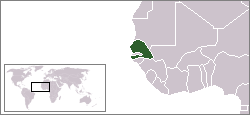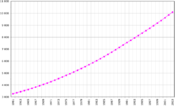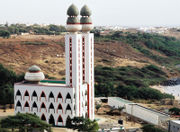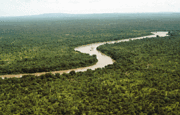Senegal
2007 Schools Wikipedia Selection. Related subjects: African Countries; Countries
| République du Sénégal Republic of Senegal |
|||||
|
|||||
| Motto: "Un Peuple, Un But, Une Foi" (French) "One People, One Goal, One Faith" |
|||||
| Anthem: Pincez Tous vos Koras, Frappez les Balafons | |||||
| Capital (and largest city) |
Dakar |
||||
| Official languages | French | ||||
|---|---|---|---|---|---|
| Government | Republic | ||||
| - President | Abdoulaye Wade | ||||
| - Prime Minister | Macky Sall | ||||
| Independence | |||||
| - from France | June 20, 1960 | ||||
| Area | |||||
| - Total | 196,722 km² ( 87th) 75,955 sq mi |
||||
| - Water (%) | 2.1 | ||||
| Population | |||||
| - 2005 estimate | 11,658,000 ( 72nd) | ||||
| - Density | 59/km² ( 137th) 153/sq mi |
||||
| GDP ( PPP) | 2005 estimate | ||||
| - Total | $20.504 billion ( 109th) | ||||
| - Per capita | $1,759 ( 149th) | ||||
| HDI (2006) | |||||
| Currency | CFA franc ( XOF) |
||||
| Time zone | UTC ( UTC) | ||||
| Internet TLD | .sn | ||||
| Calling code | +221 | ||||
Senegal (French: le Sénégal), officially the Republic of Senegal, is a country south of the Sénégal River in western Africa. Senegal is bounded by the Atlantic Ocean to the west, Mauritania to the north, Mali to the east, and Guinea and Guinea-Bissau to the south. The Gambia lies almost entirely within Senegal, surrounded on the north, east and south; from its western coast, The Gambia's territory follows the Gambia River more than 300 km inland. The Cape Verde islands lie some 560 km (348 miles) off the Senegalese coast.
History
Senegal has a very varied cultural history and a history of kingdoms, empires, brotherhoods and colonial struggles (between and against colonizing powers). Various kingdoms and empires have ruled various parts of Senegal:
Eastern Senegal was once part of the Empire of Ghana. The Kingdom of Tekrur was founded by the Tukulor in the middle valley of the Senegal River. The Senegalese Empire of Jolof (Diolof) at one time included the Kingdoms of Waalo, Bethio, Cayor, Baol, and parts of Sine and Saloum. All of these later split from Jolof, which remained as a kingdom until conquered by the French. The kingdoms of Saloum, Sine and Biffeche continue today along with tributary monarchies like Gandiaye, and the hereditary Princes of Bethio and Jolof (whose kingdoms no longer exist) are still locally revered. The Layene today is a small theocracy of the Lebou people, at Yoff near Dakar, ruled by a Grand-Khalifa. Waalo, Cayor, Beetyo were ethnic Wolof kingdoms, while Sine, Saloum and sometimes Baol were ethnic Serer kingdoms. The Biffeche kingdom has passed among different ethnic groups. The empire of Jolof was of course dominated by the Wolof ethnic group (derived from that word). Waalo, followed by Jolof, Cayor, Baol, Sine and Saloum were all conquered by the French in the 19th Century.
A noteworthy feature of the Wolof, Serer and other ethnic groups is a somewhat rigid "caste" system with complicated classes. The Jola are more egalitarian. There is a paradox in that the modern, democratic Senegal state has abolished most official caste distinctions, yet most Senegalese cling to, and many often enjoy, their inegalitarian traditions.
Separate from the institutions of the state, and from the kingdoms, is the important system of Muslim brotherhoods of Senegal, including the Xaadir (Qadriyya), the Tijanes (Tidianes) and the Mourides. These are a powerful influence in Senegalese life and politics.
The two main recent exceptions to the ethnic harmony described above are an ongoing, low-level violent struggle for autonomy, mostly by Jola, in Casamance in the South (south of The Gambia), and, in 1989-1993, a series of violent black attacks on the Moors in retaliation for violent attacks on blacks in Mauritania, which erupted from a single dispute over a grazing camel. Most Moors left Senegal after hundreds were killed.
Demographics
Senegal has a population of some 11 million, about 70 percent of whom live in rural areas. Density in these areas varies from about 77 km² in the west-central region to 2 km² in the arid eastern section.
Ethnicity
Senegal has a wide variety of ethnic groups and, as in most West African countries, several languages are widely spoken. The Wolof are the largest single ethnic group in Senegal at 43%; the Fula and Tukulor (24%) are the second biggest group, followed by others that include the Serer (15%), Lebou (10%), Jola (4%), [[Mandinka people|Mandinka]3%],[Maures orNaarkajors], Toucouleur, Soninke, Bassari and many smaller communities (9%). About 50,000 Europeans (1%) (mostly French) as well as smaller numbers of Mauritanians and Lebanese reside in Senegal, mainly in the cities. Also located primarily in urban settings are the minority Chinese and Vietnamese communities. From the time of earliest contact between Europeans and Africans along the coast of Senegal, particularly after the establishment of coastal trading posts during the fifteenth century, communities of mixed African and European (mostly French and Portuguese) origin have thrived. Cape Verdeans living in urban areas and in the Casamance region represent another recognized community of mixed African and European background. French is the official language, used regularly by a minority of Senegalese educated in a system styled upon the colonial-era schools of French origin (Koranic schools are even more popular, but Arabic is not widely spoken outside of this context of recitation). Most people also speak their own ethnic language while, especially in Dakar, Wolof is the Lingua Franca. Portuguese Creole is a prominent minority language in Ziguinchor, regional capital of the Casamance, where some residents speak Kriol, primarily spoken in Guinea-Bissau. Cape Verdeans speak their native creole.
Religion
Islam is the predominant religion, practiced by approximately 94 percent of the country's population; the Christian community, at 4 percent of the population, includes Roman Catholics and diverse Protestant denominations. There is also a tiny minority who practice animism,particularly in the southeastern region of the country.
Islam
Islamic communities are generally organized around one of several Islamic Sufi orders or brotherhoods, headed by a khalif (xaliifa in Wolof, from Arabic khalīfa), who is usually a direct descendant of the group’s founder. The two largest and most prominent Sufi orders in Senegal are the Tijaniyya, whose largest sub-groups are based in the cities of Tivaouane and Kaolack, and the Murīdiyya (Murid), based in the city of Touba. The Halpulaar, a widespread ethnic group found along the Sahel from Chad to Senegal, representing 20 percent of the Senegalese population, were the first to be converted to Islam. The Halpulaar, composed of various Fula people groups, named Peuls and Toucouleurs in Senegal. Many of the Toucouleurs, or sedentary Halpulaar of the Senegal River Valley in the north, converted to Islam around a millennium ago and later contributed to Islam's propagation throughout Senegal. Most communities south of the Senegal River Valley, however, were not thoroughly Islamized until the nineteenth and early twentieth centuries. During the mid-nineteenth century, Islam became a banner of resistance against the traditional aristocracies and French colonialism, and Tijānī leaders Al-Hajj Umar Tall and Màbba Jaxu Ba established short-lived but influential Islamic states but were both killed in battle and their empires than annexed by the French.
The spread of formal Quranic school (called daara in Wolof) during the colonial period increased largely through the effort of the Tijaniyya. In Murid communities, which place more emphasis on the work ethic than on literary Quranic studies, the term daara often applies to work groups devoted to working for a religious leader. Other Islamic groups include the much older Qādiriyya order and the Senegalese Laayeen order, which is prominent among the coastal Lebu. Today, most Senegalese children study at daaras for several years, memorizing as much of the Qur'an as they can. Some of them continue their religious studies at informal Arabic schools (majlis) or at the growing number of private Arabic schools and publicly funded Franco-Arabic schools.
Christianity
Small Roman Catholic communities are mainly found in coastal Serer, Jola, Mankanya and Balant populations, and in Oriental Senegal among the Bassari and Coniagui. In Dakar, Catholic and Protestant rites are also practiced by a portion of the Lebanese, Capeverdian, European, and American immigrant population, and among certain Africans of other countries. Although Islam is Senegal's majority religion, Senegal's first president, Léopold Sédar Senghor, was a Catholic Serer.
Other religions
Other religions in Senegal are mostly Animism, followed by Judaism and Buddhism. Judaism is followed by any people beyond racial lines and Buddhism is followed by a number of Chinese and Vietnamese.
Administrative divisions
Senegal is divided into eleven regions (régions) and subdivided into thirty-four departments (départements), ninety-four arrondissements and multiple communes. The regions are:
|
|
|
|





